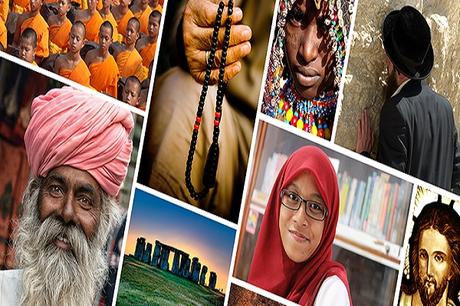
Religion is an anthology of artistic schemes, faith schemes, and worldviews that setups signs that narrate humankind to mysticism and, sometimes, to ethical principles. Many religions have narratives, symbols, traditions and sacred histories that are intended to give meaning to life or to explain the origin of life or the universe. They tend to derive morality, ethics, religious laws or a preferred lifestyle from their ideas about the cosmos and human nature.
The word religion is sometimes used interchangeably with faith or belief system, but religion differs from private belief in that it has a public aspect. Most religions have organized behaviours, including clerical hierarchies, a definition of what constitutes adherence or membership, congregations of laity, regular meetings or services for the purposes of veneration of a deity or for prayer, holy places (either natural or architectural), and/or scriptures. The practice of a religion may also include sermons, the commemoration of the activities of a god or gods, sacrifices, festivals, feasts, trance, initiations, funerary services, matrimonial services, meditation, music, art, dance, public service, or other aspects of human culture.
The development of religion has taken different forms in different cultures. Some religions place an emphasis on belief, while others emphasize practice. Some religions focus on the subjective experience of the religious individual, while others consider the activities of the religious community to be most important. Some religions claim to be universal, believing their laws and cosmology to be binding for everyone, while others are intended to be practised only by a closely defined or localized group. In many places, religion has been associated with public institutions such as education, hospitals, the family, government, and political hierarchies.
Some academics studying the subject have divided religions into three broad categories: world religions, a term which refers to transcultural, international faiths; indigenous religions, which refers to smaller, culture-specific or nation-specific religious groups; and new religious movements, which refers to recently developed faiths. One modern academic theory of religion, social constructionism, says that religion is a modern concept that suggests all spiritual practise and worship follows a model similar to the Abrahamic religions as an orientation system that helps to interpret reality and define human beings, and thus religion, as a concept, has been applied inappropriately to non-Western cultures that are not based upon such systems, or in which these systems are a substantially simpler construct.
There are a number of religions that exist in this world, but here are the most common ones and a brief look a what they are all about…

10. Shintoism

Shinto includes religious designs and follows native to Japan. Earliest Shinto paid attention on the adoration of the kami, a congregation of mystical creatures that could be known through outward appearances (entities of natural world, extraordinary inhabitants, theoretical perceptions such as impartiality) but was eventually strange. Shinto has no formal dogma and no holy writ, though early collections of Japanese religious thought and practice (Kojiki, “Records of Ancient Matters,” A.D. 712, and Nihon shoki, “Chronicles of Japan,” A.D. 720) are highly regarded.
Shinto has been influenced by Confucianism and by Buddhism, which was introduced in Japan in the 6th century. Syncretic schools (such as Ryobu Shinto) emerged, as did other sects that rejected Buddhism (such as Ise Shinto).
Under the reign of the emperor Meiji (1868–1912), Shinto became the official state religion. State Shinto, the national cult, emphasized the divinity of the emperor, whose succession was traced back to the first emperor, Jimmu (660 B.C.), and beyond him to the sun goddess Amaterasu-o-mi-kami. State Shinto was disestablished after World War II.
Sect Shinto, deriving from sects that developed during the 19th and 20th centuries, continues to thrive in Japan. Shrines dedicated to particular kami are visited by parishioners for prayer and traditional ceremonies, such as presenting a newborn child to the kami. Traditional festivals celebrated at the shrines include purification rites, presentation of food offerings, prayer, sacred music and dance, and a feast.
No particular day of the week is set aside for prayer. A person may visit a shrine at will, entering through the torii (gateway). It is believed that the kami can respond to prayer and can offer protection and guidance.
A variety of Shinto sects and practices exist today. Tenrikyo emphasizes faith healing. Folk Shinto is characterized by the veneration of roadside shrines and rites related to agriculture. Buddhist priests serve at many Shinto shrines, and many families keep a small shrine, or god-shelf, at home. Veneration of ancestors and pilgrimage are also common practices.

9. Jainism
Jainism [i.e., the religion of Jina], a sacred scheme of India performed by about 5,000,000 individuals. Jainism, Ajivika, and Buddhism occurred in the 6th century. B.C. as an objection against the overdeveloped ritualism of Hinduism, predominantly its give up factions and the influence of the Veda. Jaina custom educates that a sequence of 24 Tirthankaras (saints) initiated the religion. The last, Vardhamana, called Mahavira [the great hero] and Jina [the victor], seems to be historical. He preached a rigid asceticism and solicitude for all life as a means of escaping the cycle of rebirth, or the transmigration of souls. Thus released from the rule of karma, the total consequences of past acts, the soul attains nirvana and hence salvation. Mahavira organized a brotherhood of monks, who took vows of celibacy, nudity, self-mortification, and fasting. Since the 1st cent. A.D., when a schism developed over the issue of nudity, there have been two great divisions of Jains, the Digambaras [space-clothed, i.e., naked] and the Svetambaras [white-clothed]. Jainists, then as now, accumulate merit through charity, through good works, and in occasional monastic retreat. Early Jainism, arising in NE India, quickly spread west, and according to tradition Chandragupta, the founder of the Maurya empire, was converted to the sect, as were several kings of Gujarat.
The Jaina canon, however, is preserved in an ancient dialect of NE India (see Prakrit Literature). As Jainism grew and prospered, reverence for Mahavira and for other teachers, historical and legendary, passed into adoration; many beautiful temples were built and cult images set up. However, as time passed, the line between Hindu and Jain became more and more unclear. Soon Hindu gods such as Rama and Krishna were drawn into the Jaina pantheon, and Hindu Brahmans began to preside at Jaina death and marriage ceremonies and temple worship. The caste system, which primitive Jainism had rejected, also became part of later Jaina doctrine. Modern Jainists, eschewing any occupation that even remotely endangers animal life, are engaged largely in commerce and finance. Among them are many of India’s most prominent industrialists and bankers as well as several important political leaders. A distinctive form of charity among Jains is the establishment of asylums for diseased and decrepit animals.
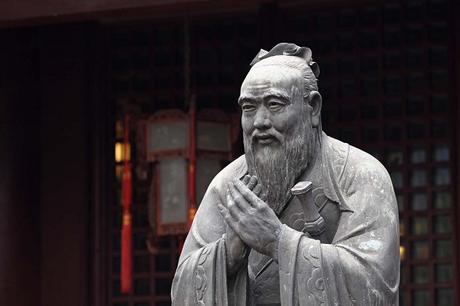
8. Confucianism
Confucianism is a Chinese moral and theoretical religion expanded from the wisdom of the Chinese theorist Confucius (Kǒng Fūzǐ, or K’ung-fu-tzu, lit. “Master Kong”, 551–478 BC). Confucianism created as an “moral-sociopolitical education” throughout the Spring and Autumn phase, but later developed metaphysical and cosmological elements in the Han Dynasty. Following the abandonment of Legalism in China after the Qin Dynasty, Confucianism became the official state ideology of China, until it was replaced by the “Three Principles of the People” ideology with the establishment of the Republic of China, and then Maoist Communism after the ROC was replaced by the People’s Republic of China in Mainland China.
The core of Confucianism is humanism, the belief that human beings are teachable, improvable and perfectible through personal and communal endeavour especially including self-cultivation and self-creation. Confucianism focuses on the cultivation of virtue and maintenance of ethics, the most basic of which are ren, yi, and li. Ren is an obligation of altruism and humaneness for other individuals within a community, yi is the upholding of righteousness and the moral disposition to do good, and li is a system of norms and propriety that determines how a person should properly act within a community. Confucianism holds that one should give up one’s life, if necessary, either passively or actively, for the sake of upholding the cardinal moral values of ren and yi. Although Confucius the man may have been a believer in Chinese folk religion, Confucianism as an ideology is humanistic and non-theistic, and does not involve a belief in the supernatural or in a personal god.
Cultures and countries strongly influenced by Confucianism include mainland China, Taiwan, Korea, Japan and Vietnam, as well as various territories settled predominantly by Chinese people, such as Singapore. Although Confucian ideas prevail in these areas, few people outside of academia identify themselves as Confucian and instead see Confucian ethics as a complementary guideline for other ideologies and beliefs, including Christianity, democracy, Marxism, capitalism, Islam and Buddhism.

7. Baha’ism
Baha’ism- religious conviction was established in Iran in the mid-19th century by Mirza Hoseyn ‘Ali Nuri, who is known as BahaUllah (Arabic: “Grandeur of God”). The foundation stone of Bahai faith is the conviction that BahaUllah and his precursor, who was known as the Bab, were manifestations of God, who in his essence is unknowable. The principal Bahai tenets are the essential unity of all religions and the unity of humanity. Bahais believe that all the founders of the world’s great religions have been manifestations of God and agents of a progressive divine plan for the education of the human race. Despite their apparent differences, the world’s great religions, according to the Bahais, teach an identical truth. BahaUllah’s peculiar function was to overcome the disunity of religions and establish a universal faith. Bahais believe in the oneness of humanity and devote themselves to the abolition of racial, class, and religious prejudices. The great bulk of Baha`i teachings is concerned with social ethics; the faith has no priesthood and does not observe ritual forms in its worship.
The Bahai religion originally grew out of the Babi faith, or sect, which was founded in 1844 by Mirza ‘Ali Mohammad of Shiraz in Iran. He proclaimed a spiritual doctrine emphasizing the forthcoming appearance of a new prophet or messenger of God who would overturn old beliefs and customs and usher in a new era. Though new, Mirza’s beliefs originated in Shiite Islam, which believed in the forthcoming return of the 12th imam (successor of Muhammad), who would renew religion and guide the faithful. Mirza ‘Ali Mohammad first proclaimed his beliefs in 1844 and assumed the title of the Bab (Persian: “Gateway”). Soon the Bab’s teachings spread throughout Iran, provoking strong opposition from both the Shi’ite Muslim clergy and the government. The Bab was arrested and, after several years of incarceration, was executed in 1850. Large-scale persecutions of his adherents, the Babis, followed and ultimately cost 20,000 people their lives.
One of the Bab’s earliest disciples and strongest exponents was Mirza Hoseyn ‘Ali Nuri, who had assumed the name of BahaUllah when he renounced his social standing and joined the Babis. Baha Ullah was arrested in 1852 and jailed in Tehran, where he became aware that he was the prophet and messenger of God whose coming had been predicted by the Bab. He was released in 1853 and exiled to Baghdad, where his leadership revived the Babi community. In 1863, shortly before being moved by the Ottoman government to Constantinople, BahaUllah declared to his fellow Babis that he was the messenger of God foretold by the Bab. An overwhelming majority of Babis acknowledged his claim and thenceforth became known as Bahais. BahaUllah was subsequently confined by the Ottomans in Adrianople (now Edirne, Tur.) and then in Acre in Palestine (now ‘Akko, Israel). Before Baha Ullah died in 1892, he appointed his eldest son, ‘Abd ol-Baha (1844-1921), to be the leader of the Bahai community and the authorized interpreter of his teachings. ‘Abd ol-Baha actively administered the movement’s affairs and spread the faith to North America, Europe, and other continents. He appointed his eldest grandson, Shoghi Effendi Rabbani (1897-1957), as his successor. The Bahai faith underwent a rapid expansion beginning in the 1960s, and by the late 20th century it had more than 150 national spiritual assemblies (national governing bodies) and about 20,000 local spiritual assemblies. After Islamic fundamentalists came to power in Iran in 1979, the 300,000 Baha`is there were persecuted by the government.
The writings and spoken words of the Bab, BahaUllah, and ‘Abd ol-Baha form the sacred literature of the Bahai faith. Membership in the Bahai community is open to all who profess faith in Baha Ullah and accept his teachings. There are no initiation ceremonies, no sacraments, and no clergy. Every Bahai, however, is under the spiritual obligation to pray daily; to fast 19 days a year, going without food or drink from sunrise to sunset; to abstain totally from narcotics, alcohol, or any substances that affect the mind; to practice monogamy; to obtain the consent of parents to marriage; and to attend the Nineteen Day Feast on the first day of each month of the Bahai calendar. The Nineteen Day Feast, originally instituted by the Bab, brings together the Bahais of a given locality for prayer, the reading of scriptures, the discussion of community activities, and for the enjoyment of one another’s company. The feasts are designed to ensure universal participation in the affairs of the community and the cultivation of the spirit of brotherhood and fellowship. Bahai houses of worship exist in Wilmette, Ill., U.S.; Frankfurt am Main, Germany; Kampala, Uganda; Sydney, Australia; and Panama City, Panama. In the temples there is no preaching; services consist of recitation of the scriptures of all religions.
The Bahais use a calendar established by the Bab and confirmed by Baha Ullah, in which the year is divided into 19 months of 19 days each, with the addition of 4 intercalary days (5 in leap years). The year begins on the first day of spring, March 21, which is one of several holy days in the Baha`i calendar.

6. Judaism
Judaism (from the Latin Iudaismus, resultant from the Greek Ioudaïsmos, and eventually from the Hebrew יהודה, Yehudah, “Judah”;in Hebrew: יַהֲדוּת, Yahedut, the distinguishing characteristics of the Judean ethnos) is the “religion, beliefs, and way of life” of the Jewish community. Originating in the Hebrew Bible (also known as the Tanakh) and explored in later texts such as the Talmud, it is considered by religious Jews to be the expression of the covenantal relationship God developed with the Children of Israel. According to Rabbinic Judaism, God revealed his laws and commandments to Moses on Mount Sinai in the form of both the Written and Oral Torah. This was historically challenged by the Karaites, a movement that flourished in the medieval period retains several thousand followers today and maintains that only the Written Torah was revealed. In modern times, liberal movements such as Humanistic Judaism may be nontheistic.
Judaism claims a historical continuity spanning more than 3,000 years. It is one of the oldest monotheistic religions, and the oldest to survive into the present day. The Hebrews / Israelites were already referred to as “Jews” in later books of the Tanakh such as the Book of Esther, with the term Jews replacing the title “Children of Israel”. Judaism’s texts, traditions and values strongly influenced later Abrahamic religions, including Christianity, Islam and the Baha’i Faith. Many aspects of Judaism have also directly or indirectly influenced secular Western ethics and civil law.
Jews are an ethnoreligious group and include those born Jewish and converts to Judaism. In 2010, the world Jewish population was estimated at 13.4 million, or roughly 0.2% of the total world population. About 42% of all Jews reside in Israel and about 42% reside in the United States and Canada, with most of the remainder living in Europe. The largest Jewish religious movements are Orthodox Judaism (Hareidi Judaism and Modern Orthodox Judaism), Conservative Judaism and Reform Judaism. A major source of difference between these groups is their approach to Jewish law. Orthodox Judaism maintains that the Torah and Jewish law are divine in origin, eternal and unalterable and that they should be strictly followed. Conservative and Reform Judaism are more liberal, with Conservative Judaism generally promoting a more “traditional” interpretation of Judaism’s requirements than Reform Judaism. A typical Reform position is that Jewish law should be viewed as a set of general guidelines rather than as a set of restrictions and obligations whose observance is required of all Jews. Historically, special courts enforced Jewish law; today, these courts still exist but the practice of Judaism is mostly voluntary. Authority on theological and legal matters is not vested in any one person or organization, but in the sacred texts and the many rabbis and scholars who interpret these texts.
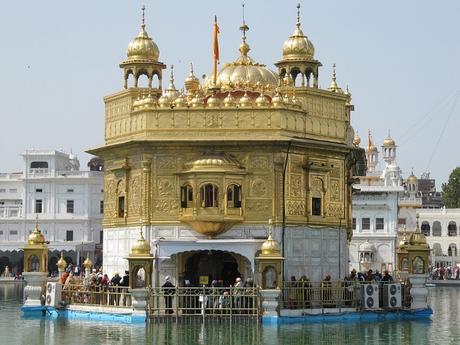
5. Sikhism
A foremost religion of India and the fifth-largest belief in the world, Sikhism came out in the Punjab below the leadership of the guru Nanak (1469–1539?). This area had been powered by the Hindu bhakti association, which endorsed equally the idea that God includes one truth alone as well as the practice of loyalty singing and prayer. The Muslim mystical tradition of Sufism, with its emphasis on meditation, also had some prominence there. Drawing on these resources, Nanak forged a new spiritual path.
In his youth, Nanak began to compose hymns. At the age of 29, he had a mystical experience that led him to proclaim “There is no Hindu; there is no Muslim.” A strict monotheist, he rejected Hindu polytheism but accepted the Hindu concept of life as a cycle of birth, death, and rebirth; moksha, release from this cycle into unity with God, could be achieved only with the help of a guru, or spiritual teacher. Nanak believed that communion with God could be gained through devotional repetition of the divine name, singing of hymns and praises, and adherence to a demanding ethical code. He rejected idols and the Hindu caste system; it became a custom for Sikhs of all social ranks to take meals together. These beliefs are still central to modern Sikhism.
Nanak was first in a line of ten gurus who shaped and inspired Sikhism. The fifth, Arjun (1563–1606), compiled hymns and other writings by earlier Sikh gurus, as well as medieval Hindu and Muslim saints, in the Adi Granth (First Book), or Guru Granth Sahib (the Granth Personified). This book became the sacred scripture of Sikhism. In addition to his spiritual leadership, Arjun wielded considerable secular power as he grappled with leaders of the Mughal Empire.
The tenth guru, Gobind Singh (1666–1708), was both a scholar and a military hero. He established the Khalsa (community of pure ones), an order that combined spiritual devotion, personal discipline, and ideals of military valor. Baptism initiates new members into the Khalsa. The Adi Granth took its final form under the supervision of Gobind Singh, as did the Dasam Granth (Tenth Book), a collection of prayers, poetry, and narrative. After the deaths of his four sons, Gobind Singh declared the line of gurus at an end. The Adi Granth would instead be reverenced in houses of worship, taking the place of a living guru.
Today, Sikhs worship at gurdwaras (temples), where the Adi Granth is the object of devotion. This book is consulted regarding questions of faith and practice. On certain occasions, it is recited in its entirety (requiring more than a day) or carried in procession; offerings may be placed before it. Worshipful singing, meditation, and focus on the divine name remain essential to spiritual life. Some Sikhs undertake pilgrimages to historical gurdwaras, such as the Golden Temple of Amritsar, that are associated with the gurus. Some become disciples of living saints. There is no established Sikh priesthood.

4. Buddhism
Buddhism was originated in the 4th or 5th century B.C. in northern India by a gentleman recognized conventionally as Siddhartha (meaning “he who has achieved the target”) Gautama, the son of a soldier prince. A number of intellectuals consider that he be alive from 563 to 483 B.C., although his accurate living period is unsure. Anxious by the belief of anguishing in human life, he left in the lurch his home and a coddled life at the age of 29 to meander as an austere, looking for spiritual approaching and an explanation of the great efforts of personal survival. He passed through many trials and practised extreme self-denial. Finally, while meditating under the bodhi tree (“tree of perfect knowledge”), he reached enlightenment and taught his followers about his new spiritual understanding.
Gautama’s teachings differed from the Hindu faith prevalent in India at the time. Whereas in Hinduism the Brahmin caste alone performed religious functions and attained the highest spiritual understanding, Gautama’s beliefs were more egalitarian, accessible to all who wished to be enlightened. At the core of his understanding were the Four Noble Truths: (1) all living beings suffer; (2) the origin of this suffering is desire—for material possessions, power, and so on; (3) desire can be overcome; and (4) there is a path that leads to release from desire. This way is called the Noble Eightfold Path: right views, right intention, right speech, right action, right livelihood, right effort, right concentration, and right ecstasy.
Gautama promoted the concept of anatman (that a person has no actual self) and the idea that existence is characterized by impermanence. This realization helps one let go of the desire for transient things. Still, Gautama did not recommend extreme self-denial but rather a disciplined life called the Middle Way. Like the Hindus, he believed that existence consisted of reincarnation, a cycle of birth and death. He held that it could be broken only by reaching complete detachment from worldly cares. Then the soul could be released into nirvana (literally “blowing out”)—an indescribable state of total transcendence. Gautama travelled to preach the dharma (sacred truth) and was recognized as the Buddha (enlightened one). After his death, his followers continued to develop doctrine and practice, which came to centre on the Three Jewels: the dharma (the sacred teachings of Buddhism), the sangha (the community of followers, which now includes nuns, monks, and laity), and the Buddha. Under the patronage of the Mauryan emperor Ashoka (third century B.C.), Buddhism spread throughout India and to other parts of Asia. Monasteries were established, as well as temples dedicated to Buddha; at shrines, his relics were venerated. Though by the fourth century A.D. Buddhist presence in India had dwindled, it flourished in other parts of Asia.
Numerous Buddhist sects have emerged. The oldest, called the Theravada (Way of the Elders) tradition, interprets Buddha as a great sage but not a deity. It emphasizes meditation and ritual practices that help the individual become an arhat, an enlightened being. Its followers emphasize the authority of the earliest Buddhist scriptures, the Tripitaka (Three Baskets), a compilation of sermons, rules for celibates, and doctrine. This sect is prevalent in Southeast Asia and Sri Lanka. It is sometimes called the Hinayana (Lesser Vehicle) tradition (once considered a pejorative term).
Between the second century B.C. and the second century A.D., the Mahayana (Greater Vehicle) tradition refocused Buddhism to concentrate less on individual attainment of enlightenment and more on concern for humanity. It promotes the ideal of the bodhisattva (enlightened being), who shuns entering nirvana until all sentient beings can do so as well, willingly remaining in the painful cycle of birth and death to perform works of compassion. Members of this tradition conceive of Buddha as an eternal being to whom prayers can be made; other Buddhas are revered as well, adding a polytheistic dimension to the religion. Numerous sects have developed from the Mahayana tradition, which has been influential in China, Korea, and Japan.
A third broad tradition, variously called Vajrayana (Diamond Vehicle), Mantrayana (Vehicle of the Mantra), or Tantric Buddhism, offers a quicker, more demanding way to achieve nirvana. Because of its level of challenge—enabling one to reach enlightenment in one lifetime—it requires the guidance of a spiritual leader. It is most prominent in Tibet and Mongolia.
Zen Buddhism encourages individuals to seek the Buddha nature within themselves and to practice a disciplined form of sitting meditation in order to reach satori—spiritual enlightenment.
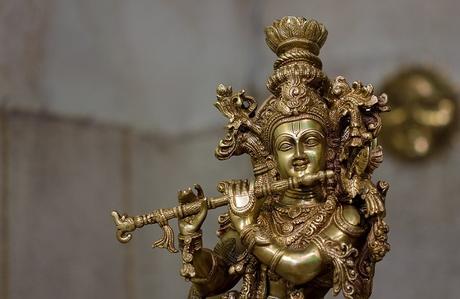
3. Hinduism
Hinduism is a religion with various gods and goddesses. According to Hinduism, three Lords rule the world. Brahma: the creator; Vishnu: the preserver and Shiva: the destroyer. Lord Vishnu did his job of preserving the world by incarnating himself in different forms at times of crisis.
The three Lords that rule the world have consorts and they are goddesses. The consort of Brahma is Sarasvati; goddess of learning. Vishnu’s consort is Lakshmi; goddess of wealth and prosperity. Shiva’s consort is Parvati who is worshipped as Kali or Durga.
Along with them, there are a number of other gods and goddesses. To name a few of them, there is Ganesh, who has an elephant’s head and he is also a son of Shiva and Parvati. Hanuman, who is an ape. Surya, Lord of the sun. Ganga Ma, goddess of river Ganges. Samundra, Lord of the sea. Indra, king of the gods ( but he isn’t an important god). Prithvi, goddess of the earth. Shakti, goddess of power. The Hindus call their goddesses ‘Ma’ meaning mother.
Some gods have more than one name. Shiva is also known as Shankar, Mahadev, Natraj, Mahesh and many other names. Ganesh is also called Ganpati. God Vishnu incarnated 9 times to do his job and in his every appearance he had a different form which is also worshipped as gods. Among his appearances, he appeared as Rama, Krishna, Narsimha, Parsuram and Buddha. Krishna also has different names, Gopal; Kishan; Shyam and other names. He also has other titles with meanings like ‘Basuri Wala’ which means the flute musician and ‘Makhan Chor’ which means the butter stealer. There are also gods who can change their forms, for example: Parvati can change into Kali or Durga.
Not all of these Gods are worshipped by all Hindus. Some Hindus worship only Vishnu. Others worship only Shiva. Others worship only the goddesses and call these Goddesses collectively as Shakti meaning power. Many of these Goddess worshipers worship Parvati in her images as Kali or Durga. People who worship Shiva or Vishnu also worship characters and images connected with these gods. Vishnu worshipers (Vaishnaites) also worship his appearances. Shiva’s worshipers (Shaivites) also worship images of a bull called Nandi, who was Shiva’s carrier and a unique stone design connected to Shiva. There are also Hindus who worship all the gods. There are some gods who are worshipped all over India like Rama and Krishna and other gods who are worshipped more in one region than the other like Ganesh who is worshipped mainly in west India. Hindus also worship gods according to their personal needs. People who engage in wrestling, bodybuilding and other physical sports worship Hanuman, who in Hindu legends was an ape with a lot of physical strength.
Businessmen worship Lakshmi, goddess of wealth. Though Hindus worship different idols, many Hindus believe in one God and perceive these different gods and goddesses as different faces of the same one God. Others believe that idolatry is the wrong interpretation of Hinduism.
Hindus believe in reincarnation. The basic belief is that a person’s fate is determined according to his deeds. These deeds in Hinduism are called ‘Karma’. A soul who does good Karma in this life will be awarded a better life in the next incarnation. Souls who do bad Karma will be punished for their sins, if not in this incarnation then in the next incarnation and will continue to be born in this world again and again. The good souls will be liberated from the circle of rebirth and get redemption which is called ‘Moksha’ meaning freedom. Hindus normally cremate their dead ones, so that the soul of the dead would go to heaven, except in a few cases of Hindu saints, who are believed to have attained ‘Moksha’.
The main Hindu books are the four Vedas. They are Rig Veda, Sama Veda, Yajur Veda and Atharva Veda. The concluding portions of the Vedas are called Upanisads. There are also other holy books like Puranas, Ramayana, Mahabharta etc. The different gods and goddesses in Hindu mythology are derived from these books. Ramayana and Mahabharta are the most popular Hindu books.
The main story of Ramayana is the story of Lord Rama. Rama was born in a royal family and was suppose to be the king, but because of his step-mother, he was forced to exile from his kingdom for fourteen years. During this period his consort Sita was kidnapped by a demon called Ravan, who was king of Lanka. Rama with the help of his brother, Lakshman, and an army of monkeys under the leadership of Hanuman, rescued Sita. Many Indians believe that present-day Sri Lanka was then the kingdom of Lanka.
Mahabharta is a family epic. In this epic the Pandava family and the Kaurav family who are cousins fight with each other for control over a kingdom. Kaurav family, which consisted of 100 brothers rule an empire. The five Pandava brothers ask for a small kingdom that belongs to them. The Kauravs refuse to give the Pandavas the kingdom so there is a war between the Pandavas and the Kauravs in which it is believed that all the kingdoms of that period in India took part. In this war the Pandavas, with the help of Lord Krishna win the war. Before the commencement of the war, while the two armies are facing each other, one of the Pandava brothers Arjun gets depressed. Arjun is depressed because he has to fight against people whom he knows, loves and respects. At this point Krishna, (who was also a king of a kingdom, and participated in this war only as the chariot driver for Arjun) convinces Arjun to fight. Krishna lectures Arjun about life, human beings and their religious duties. He explains to Arjun that he belongs to a warrior caste and he has to fight for that’s his destination in this incarnation. Those chapters in the Mahabharta which are Krishna’s discourses on religious philosophy are called Bhagvad Gita. Because of it’s importance, the Bhagavad Gita is considered as a separate holy book. Another Hindu holy book that deals with religious duties is ‘Law of Manu’ or the ‘Dharma Shastra’.
In the wars that occur in the holy books, as in Mahabharta, the different sides had different war weapons which had characters similar to modern-day war weapons. In some stories, the travelling vehicles were normally birds and animals. But these animals and birds had features similar to modern-day aircraft. There were even aircraft with over velocity of light. The main war weapons were bows and arrows. But these arrows were more like modern missiles than simple arrows. These arrows were capable of carrying bombs with destructive power similar to modern-day chemical, biological or even atom bombs. Other arrows could be targeted on specific human beings. There were even arrows capable of neutralizing other arrows, similar to modern-day anti-missiles.
Hindus have many holy places. Badrinath, Puri, Dwarka and Rameshwaram are the four holiest places for the Hindus. Other holy places are Varanasi, Rishikesh, Nasik, Pushkar, Ujjain and other places. Some rivers are also holy to them. Among them are Godavari, Yamuna and above all Ganges which the Indians call Ganga. Another holy river is Sarasvati and it is invisible. Hindus also worship and respect some animals and birds like cobra, apes, peacocks and cow. Hindus also respect some trees and bush trees. The famous and the most respected bush tree is Tulsi.
Some of the Hindu customs, which exist or existed, do not have their bearing in Hindu scriptures but became part of Hinduism in different ways and fashion. For example, the Hindus see in cow a sacred animal. Religiously there is no reason to see cow as sacred and it is believed that cows were made ‘sacred’ to prevent their slaughter during periods of droughts and hunger. Cobra worship also is not found in Hindu scripts. This custom became part of Hinduism when some Indian tribes who use to worship cobra adopted Hinduism. The burning of the widow on the dead husband’s pyre also has no religious justification. This custom, outlawed in 1829, was probably brought to India by the Scythians invaders of India. Among the Scythians, it was a custom to bury the dead king with his mistresses or wives, servants and other things so that they could continue to serve him in the next world. When these Scythians arrived in India, they adopted the Indian system of funeral, which was cremating the dead. And so instead of burying their kings and his servers, they started cremating their dead with his surviving lovers. The Scythians were warrior tribes and they were given the status of warrior castes in the Hindu religious hierarchy. The different castes who claimed warrior status or higher also adopted this custom.
There are four castes in Hindu religion arranged in a hierarchy. The highest caste is Brahman, and they are the priest caste of Hinduism. After them are the Kshatria, who are the warrior castes. After them are the Vaishya caste, who are business people and after they are the Sudra, who are the common peasants and workers. Below these four castes there are casteless, the untouchables. The four castes were not allowed to have any physical contact with the untouchables.
Each caste is divided into many sub-castes. The religious word for caste is Varna and for sub-caste Jat or Jati. But sometimes in English, the term caste is used in both cases. Religiously, people are born in a caste and it cannot be changed. Each caste has some compulsory duties, which its members must do. Each caste has professional limits which decide what profession each caste can follow. Each caste members can have social relations only with its caste members. Religiously this includes marriage and even eating only with caste members. Please note that socially the caste system is different from the religious form of caste system.
How did Hinduism originated is a difficult question. The accepted theory is that Hinduism was evolved after the historical meeting between the Aryans and Dravidians. Some claim that Hinduism is mainly an Aryan culture whereas others claim that it is mainly a Dravidian culture. Religiously the Vedas were given by Brahma.
Before Hinduism, there existed another religion in India called Brahmanism and its followers were called Brahmans. The Brahmans were the spiritual and moral guides of Indian society. The members of this religion were a close sect and others could not join it. The Brahmans slowly started accepting others into their religion and so was created Hinduism which included in it the customs which were not part of the Vedas. One of the reasons the Brahmans accepted others to their religion was the fear to lose their status as moral guides to priests of a new religion that started in India, namely Buddhism. The Brahmans even accepted Buddha as an incarnation of Lord Vishnu and part of his teachings and philosophy like non-violence into their religion.
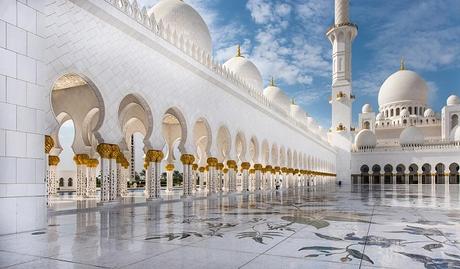
2. Islam
Islam, one of the 3 most important monotheistic beliefs, was established in Arabia by Muhammad (PBUH) between 610 and 632.
Islam means submission to Allah (God). Islam was revealed to the Prophet Muhammad (PBUH) who lived from 570 CE to 632 CE in Mecca in modern-day Saudi Arabia. Muhammad (PBUH) was called to prophethood when God dictated the Qur’an to Him (PBUH) through the angel Gabriel. Although He (PBUH) gained a small following in His tribe, Muhammad (PBUH) was initially persecuted for His beliefs. In 622 CE He (PBUH) fled to Yasrab, now called Medina, where the first Muslim political community was formed. Enlisting the help of nomadic Arab clans, Muhammad (PBUH) returned to Mecca, stripping the city of all signs of pagan belief. He was generous to those He (PBUH) defeated, however, and many converted to Islam. Two years later, in front of the Ka’ba in Mecca, He (PBUH) declared Islam the religion of the people, saying He (PBUH) had fulfilled His mission and that He left behind him the Book of Allah and a set of clear commandments.
The Hegira (Hijra, meaning “emigration”) of Muhammad (PBUH) from Mecca, where He (PBUH) was not honoured, to Medina, where He (PBUH) was well-received, occurred in 622 and marks the beginning of the Muslim era. After a number of military conflicts with Mecca, in 630 he marched on Mecca and conquered it. Muhammad (PBUH) died at Medina in 632.
Muhammad’s (PBUH) followers, called Muslims, revered him as the prophet of Allah (God), the only God. Muslims consider Muhammad (PBUH) to be the last in the line of prophets that included Abraham and Jesus. Islam spread quickly, stretching from Spain in the west to India in the east within a century after the prophet’s death. Sources of the Islamic faith are the Qur’an (Koran), regarded as the uncreated, eternal Word of God, and tradition (hadith) regarding the sayings and deeds of the prophet.
Islam means “surrender to the will of Allah,” the all-powerful, who determines humanity’s fate. Good deeds will be rewarded at the Last Judgment in paradise, and evil deeds will be punished in hell.
The Five Pillars, or primary duties, of Islam, are profession of faith; prayer, to be performed five times a day; almsgiving to the poor and the mosque (house of worship); fasting during daylight hours in the month of Ramadan; and pilgrimage to Mecca (the hajj) at least once in a Muslim’s lifetime, if it is physically and financially possible. The pilgrimage includes an homage to the ancient shrine of the Ka’aba, the most sacred site in Islam.
Muslims gather for corporate worship on Fridays. Prayers and a sermon take place at the mosque, which is also a centre for the teaching of the Qur’an. The community leader, the imam, is considered a teacher and prayer leader.
Islam succeeded in uniting an Arab world of separate tribes and castes, but disagreements concerning the succession of the prophet caused a division in Islam between two groups, Sunnis and Shi’ites. The Shi’ites rejected the first three successors to Muhammad as usurpers, claiming the fourth, Muhammad’s (PBUH) son-in-law Ali, as the rightful leader. The Sunnis (from the word tradition), the largest division of Islam (today more than 87%), believe in the legitimacy of the first three successors. Among these, other sects arose (such as the conservative Wahhabi of Saudi Arabia), as well as different schools of theology. Another development within Islam, beginning in the eighth and ninth centuries, was Sufism, a form of mysticism. This movement was influential for many centuries and was instrumental in the spread of Islam in Asia and Africa.
Islam has expanded greatly under Muhammad’s (PBUH) successors. It is the principal religion of the Middle East, Asia, and the northern half of Africa.
In 1990 there were an estimated 935 million Muslims worldwide, fewer than one-fifth of whom were Arab. Islam is the principal religion of much of Asia, including Indonesia (which has the world’s largest Muslim population), Afghanistan, Malaysia, Pakistan, Bangladesh, Azerbaijan, Turkmenistan, Uzbekistan, Tajikistan, Kyrghyzstan, Kazakhstan, Iran, Iraq, Syria, Jordan, the Arab states, and Turkey; in Africa, of Egypt, Algeria, Tunisia, Djibouti, Gambia, Guinea, Libya, Mali, Mauritania, Morocco, Niger, Senegal, Somalia, Sudan, with sizable populations also in Chad, Eritrea, Ethiopia, Ghana, Tanzania (where the island of Zanzibar is predominantly Muslim), and Nigeria.
In Europe, Albania is predominantly Muslim, and, historically, Bulgaria, Bosnia, Macedonia, and Georgia have had Muslim populations. Elsewhere in Europe, immigrant communities of Muslims from N Africa, Turkey, and Asia exist in France, Britain, and Germany. In the Americas the Islamic population has substantially increased in recent years, both from conversions and the immigration of adherents from other parts of the world; 20% of the population of Suriname is Muslim.
Estimates of the total number of Muslims range from 0.7 to 1.8 billion worldwide and 1.1 to 7 million in the U.S. 3 We accept the best estimate as 1.57 billion, concluded by the few Forums. About 23% of all people on Earth follow Islam. The religion is currently in a period of rapid growth.
Christianity is currently the largest religion in the world. It is followed by about 33% of all people — a percentage that has remained stable for decades. If current trends continue, Islam will become the most popular world religion sometime in the mid-21st century.

1. Christianity
Christianity is a monotheistic religion founded on the existence and wisdom of Jesus as at handed in canonical gospels and other new evidence scripts. Believers of the Christian belief are recognized as Christians.
Christianity teaches that Jesus is the Son of God, God having become human and the saviour of humanity. Because of this, Christians commonly refer to Jesus as Christ or Messiah. The three largest groups in the world of Christianity are the Roman Catholic Church, the Eastern Orthodox churches, and the various denominations of Protestantism. The Roman Catholic and Eastern Orthodox patriarchates split from one another in the East–West Schism of 1054 AD, and Protestantism came into existence during the Protestant Reformation of the 16th century, splitting from the Roman Catholic Church.
Christianity began as a Jewish sect in the mid-1st century. Originating in the eastern Mediterranean coast of the Middle East (modern Israel and Palestine), it quickly spread to Syria, Mesopotamia, Asia Minor and Egypt, it grew in size and influence over a few decades, and by the 4th century had become the dominant religion within the Roman Empire. During the Middle Ages, most of the remainder of Europe was Christianized, with Christians also being a sometimes large religious minority in the Middle East, North Africa, Ethiopia and parts of India. Following the Age of Discovery, through missionary work and colonization, Christianity spread to the Americas, Australasia, sub-Saharan Africa and the rest of the world. In order to follow Jesus’ command to serve others, Christians established hospitals, churches, schools, charities, orphanages, homeless shelters, and universities in the areas in which they spread Christianity.
Christians believe that Jesus is the Messiah prophesied in the Hebrew Bible, referred to as the “Old Testament” in Christianity. The foundation of Christian theology is expressed in the early Christian ecumenical creeds which contain claims predominantly accepted by followers of the Christian faith. These professions state that Jesus suffered, died, was buried, and was resurrected from the dead to open heaven to those who believe in him and trust him for the remission of their sins (salvation). They further maintain that Jesus bodily ascended into heaven where he rules and reigns with God the Father. Most denominations teach that Jesus will return to judge all humans, living and dead, and grant eternal life to his followers. He is considered the model of a virtuous life, and both the revealer and physical incarnation of God. Christians call the message of Jesus Christ the Gospel (“good news”) and hence refer to the earliest written accounts of his ministry as gospels.
As of the early 21st century, Christianity has approximately 2.2 billion adherents. Christianity represents about a quarter to a third of the world’s population and is the world’s largest religion. Christianity is the state religion of several countries. Among all Christians, 37.5% live in the Americas (11.4% in the United States), 25.7% live in Europe, 22.5% live in Africa, 13.1% live in Asia, 1.2% live in Oceania and 0.9% live in the Middle East.

